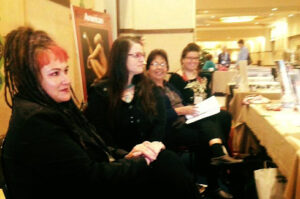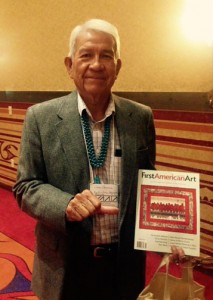The Native American Art Studies Association (NAASA) held its 20th biennial conference last weekend north of Santa Fe. Being in New Mexico was homecoming for the organization, since it was founded in Albuquerque. With about 240+ participants, this conference was its largest Thanks to the convenient location at the Pojoaque Pueblo’s Buffalo Thunder Resort, it was easy for locals to drop by and visit old friends and colleagues.
NAASA is a mix of art historians, anthropologists, art critics, curators, artists, and other art and museum professionals. Native American studies is usually an interdisciplinary field at colleges, and only approximately a half-dozen institutions offer doctorates in Native American art history, so NAASA draws from many constituencies to explore Native art history, theory, criticism, and practicum and is a unifying force for the field of Native American art.
Bob Haozous (Chiricahua Apache) delivered the keynote address, accompanied by Rose Simpson (Santa Clara) and Emily Haozous, PhD, RN (Chiricahua Apache), who delivered a moving rendition of her father’s poetry. Plenary sessions followed, first featuring a range of talented local artists then Native art curators working in a range of venue: tribal museum, tribal college, casino, and museum store. Rebecca Trautman took excellent care of the publishers: University of New Mexico Press, University of Seattle Press, and us.
A lunchtime discussion of Native arts publications was far better attended than anticipated. The shuttering of American Indian Art Magazine meant the loss of a peer-reviewed journal, needed not only by faculty but also masters and doctoral candidates. The prospects of launching a new journal look grim; however, Native American Studies journals such as American Indian Quarterly, American Indian Culture and Research Journal, Native American and Indigenous Studies Association, Native Studies Review, and Wicazo Sa Review all accept submissions about Native art. The Inuit Foundation recently revived its Inuit Art Quarterly. Art and culture journals, including the University of New Mexico’s Hemisphere: Visual Cultures of the Americas, accept submissions from scholars from other institutions.

Think tank with, left to right, Emil Her Many Horses (Oglala Lakota), NMAI; Christina Burke, Philbrook Museum of Art; John Lukavic, Denver Art Museum;Jill Ahlberg Yohe, Minneapolis Institute of Art; and friends. All images © Marlowe Katoney, used with permission.
The newly elected NAASA board members are:

NAASA attendees including Marlowe Katoney (Navajo), far right, and David Sloan (Navajo), who produced the NAASA program cover art, back right.
- Deana Dartt-Newton (Chumash descent)
- Emil Her Many Horses (Oglala Lakota)
- Joe Horse Capture (A’aninin)
- Heather Igloliorte (Inuk)
- Henrietta Lidchi, Vice-President
- Amy Lonetree (Ho-Chunk)
- Kate Morris, President
- Sherry Farrell Racette (Métis)
- Ryan Rice (Mohawk).
At the final banquet, Ann Fienup-Riordan was honored. She graciously thanked her Yupik and other colleagues who made her books possible.
The next NAASA conference will take place in Tulsa, Oklahoma (Muscogee Creek turf!) in 2017.
The entire NAASA conference program with abstracts is available online here.

FAAM crew tabling at NAASA: Melissa Dominguez, Heather Gross, Linda Lomahaftewa (Hopi-Choctaw), and Neebinnaukzhik Southall (Rama Chippewa)






2 Comments
Hello! I am interested in seeing the 2015 conference program and abstracts, but the link is not functioning. Is there any way I could see these documents?
Thank you very much
Colette Hyman
Professor of History
Winona State University
Winona, MN 55987
Hi Colette, Poking around the Internet, we can’t find the program either. Perhaps you might inquire on NAASA’s Facebook page? It’s at http://www.facebook.com/naasaart. Best of luck!